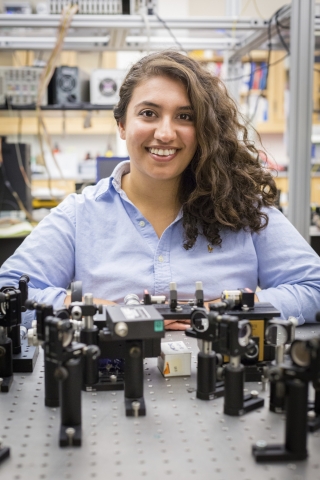Physics graduate student Leily Kiani has completed the entirety of her higher education at UC Merced, all while the campus grew up around her.

A member of the inaugural 2005 freshman class, Kiani remembers that first year fondly. “It was a little chaotic at times, but my entire undergraduate class is so close-knit because we all found our way together,” she said. “I formed the most amazing and lasting friendships during that time.”
During her undergraduate years, Kiani was selected to be a member of UC Merced’s California Alliance for Graduate Education and the Professoriate (AGEP) program. As part of the program, she worked as a researcher in professor Jay Sharping’s lab and measured ultrafast pulses of light using frequency-resolved optical gating (FROG) technique.
“I didn’t appreciate the difficulty and technicality of the project at the time, but it speaks to the kind of intensive undergraduate research that UC Merced promotes,” Kiani said. “It really helped to prepare me for Ph.D. work.”
After she graduated in 2009, Kiani took a year off and worked for a small startup company, but she eventually decided that graduate school was the next step for her. When she was accepted at UC Merced, she was happy to return and continue the research that she had started with Sharping.
Over the course of her graduate career, Kiani has worked on a number of related projects that center around developing and testing parametric devices based on microstructure optical fibers. Most recently, Kiani has been studying polarization dynamics in a fiber optical parametric oscillator (FOPO) that she helped to design and build with her group.
The FOPO is a tunable laser-like light source that allows scientists to perform complex spectroscopic measurements — specifically, coherent Raman spectroscopy. As Kiani puts it, “this allows us to see how much of a ‘thing’ is there.” The FOPO is quite powerful, so the “thing” being measured could be anything from a lipid inside a cell to a chemical in the atmosphere.
Kiani has been experimenting to increase the power of the FOPO.
“You have to ‘couple out’ some of the power in the cavity of the device in order to actually use it, but doing so means that you’re not operating at maximal efficiency,” Kiani explained. “By playing with the polarization state, we found that you can get up to 20 percent more power out of the device, which of course only increases its usefulness.”
Typical optical parametric oscillators are generally built around a crystal rather than fibers, but Kiani’s group believes that FOPOs are much more implementable and customizable, especially for aerospace and biomedical uses.
Once her research is complete and her Ph.D. is awarded this summer, Kiani is looking forward to applying for postdoctoral and National Research Council (NRC) fellowships, but ultimately, she hopes to return to industry.’
“I could really see myself returning to a smaller startup again,” she said. “It’s a type of environment in which I think I could really thrive.”



